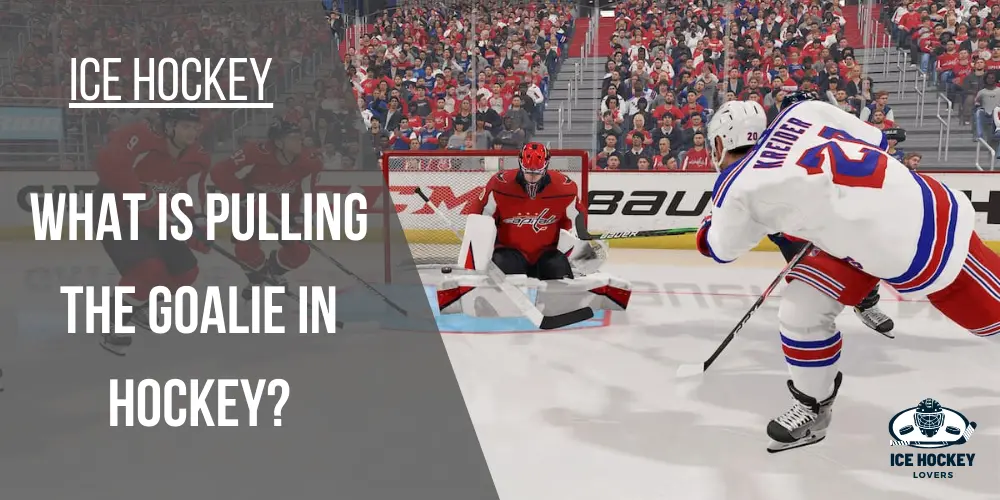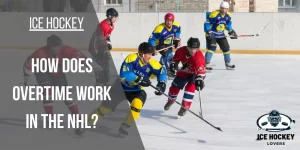What is Pulling the Goalie in Hockey?

Often in a hockey game, one of the teams might pull the goalkeeper and replace him with another attacking player to score against the opposing team. This might sound unusual as pulling the goalie leaves the net empty, but this move is often used by times. Therefore, to know the strategy behind this, how successful this is, and much more, continue reading the blog.
In ice hockey, teams sometimes pull their goalie on a coach’s strategy as an extra attacker at the final moments to score a goal to increase or balance their fixed points against the opponents. The offensive players get on the ice when a goaltender comes across the ice. It’s a risky play but gives a team an offensive advantage, and it worked 18.1% in the 2020-21 season.
Table of Contents
History of Pulling a Goalie in Hockey
The coach/GM of the Boston Bruins used this move in 1931. During a match against Montreal, Canadiens Ross had Tiny Thompson return to the bench to add offence. Although this did not earn them goals, other teams learned much from Ross’s move.
What is the Strategy behind Pulling the Goalie?
The strategy behind pulling the goalie is to replace him with another offensive player to have a higher chance of scoring against the opposing team. This move is used when a team is down in goals. Pulling the goalie and replacing him with an attacking player increases the chance of having a numerical advantage.
What is the Right Timing for Pulling the Goalie?
The right time to pull the goalie is during the third period. Pulling the goalie in the first or send period is not any benefitting. Pulling the goalie in the third period means going all in with other players to score. Teams practice these drills during practice.
How Effective is Pulling your Goalie?
During the 2020-21 season, the team who pulled their goalie scored one goal 18.1% of the time, according to Hall’s research. During the previous season, it was about 15% and the same as the season before that.
What if the opposing team scores against an empty net?
If the opposing team scores against the opposing team’s empty net, then the team earns an open net goal. The opposing team often shoots from a distance or scores into the net while being closer to it and attaining an empty score goal.
What if a team scores in its empty net?
In many instances, what happens is that a team scores in its empty net. This usually happens when a teammate misses the pass, and the puck reaches the net. In this case, the player from the opposing team who had previously contacted the puck earns scoring credit.
Can a Goalie Return after being Pulled?
Yes, a goalie can return to guard the net after being pulled. If a team scores after pulling the goalie and the time is left, the goalie can return to defend the net.
What if you pull your Goalie during a Delayed Penalty?
Another way of pulling your goalie is during a delayed penalty. During a delayed penalty, the game is over as soon as the opposing team gains possession of the puck; coaches swap their goalies with a hockey player when the delayed penalty occurs.
Do the Goalies need to signal anything?
When the goalie is being pulled out, the goalie raises his arms. This signals that the goalie is leaving and is being replaced with another player.
The First Goalie Pulls in NHL
Tiny Tompson was the first player pulled out of the goalie due to an injury. So his coach decided to put him on the ice with the help of a man who was not on the roster.
What is 6V4 time?
6v4 means that a time can do 11 goals in 60 minutes, whereas 5v4 means that a team can perform 12 goals in 60 minutes. The teams are spending more time on 6v4 than on 6v5. So the teams should adopt 6v5 rather than 6v4.
Future of pulling the Goalie?
The reason for pulling the goalie is that on the power play, a team outnumbered by two players or outnumbered 5-on-3 pulls their goaltender to create a 6-on-3 advantage. While this is only used for minor league or international hockey now, there may be a place for it in the future.
Frequently Asked Questions
Why does the team not pull the goalie during the power play?
Following are the reasons: At first, the power play has already given them a chance to score more; therefore, they think it is better to use power play rather than pull the goalie. Secondly, this is because removing the goalie takes more time than doing a goal, as the time is left with less time. So, a goal is preferred.
After the goalie gets pulled, can he come back into his net?
Yes, it is not against the rule that the goalie can come back into the net after being pulled out; there is no harm in it.
Why does a goalie get credit for hockey wins?
In hockey, if a team wins, the goalie is responsible for it because he was in his net. When the team scores, time is not the factor on which the team’s success is measured, but how it is in the net matters.
Why don’t the coaches pull their goalie earlier in the game than in the last seconds?
Pulling a goalie is taking a risk, and nobody wants to take a risk at the start when there is time to turn over a game and apply other strategies because pulling a goalie is leaving a net unsafe, which goes against the team’s advantage. Hence, coaches choose this option when they have no other options. Also, what matters for coaches is game planning and putting it in according to the game; not winning a game is crucial for them. Because if they rush with strategies without proof thinking, then that might become a recipe for them being removed as a coach.
Conclusion
Hockey fans are always excited about this game; the game could be more successful if the goalie is pulled at the end of the game. The success rate of this game during the NHL session 2019-2020 was 14.5%. Another strategy is pulling the goalie in and leaving the nets empty to tie the game or win. It not always works, but when it does, it’s magical.
The rules for this game are also changed from pulling the goalie from the ice box to knee to knee.
Related Posts:

Who is Austin Taylor?
Meet Austin Taylor, your go-to source for everything ice hockey! With a passion for the sport that’s as deep as the ice itself, Austin Taylor brings you concise, expert insights and nitty-gritty details on all things hockey. From gear reviews to strategy breakdowns, Austin Taylor is your trusted guide to navigating the exhilarating world of ice hockey. Get ready to lace up your skates and dive into the game with Austin Taylor as your ultimate companion.




